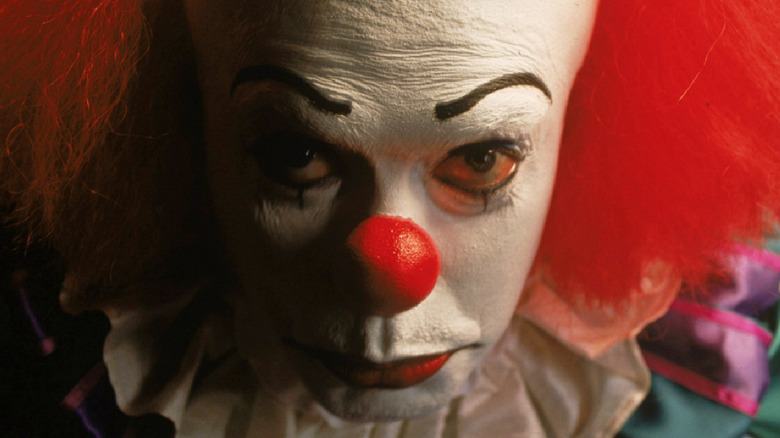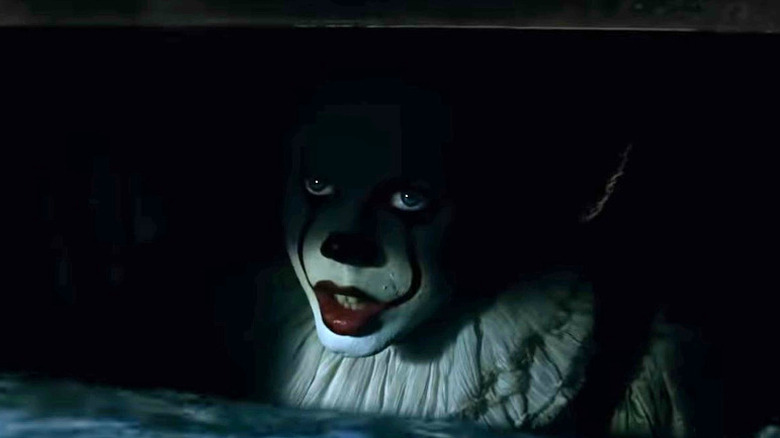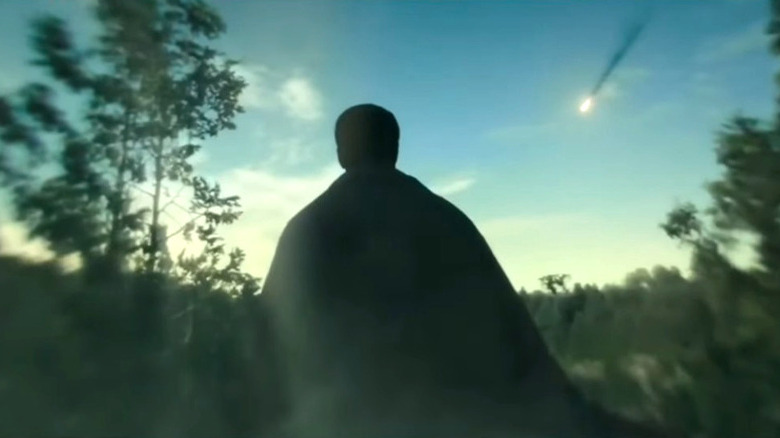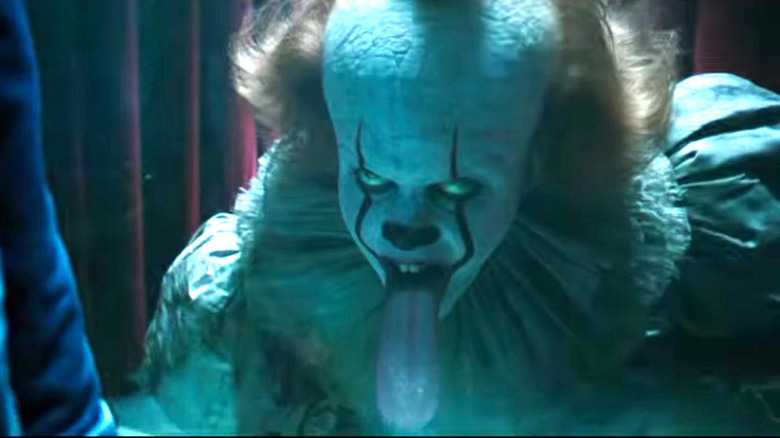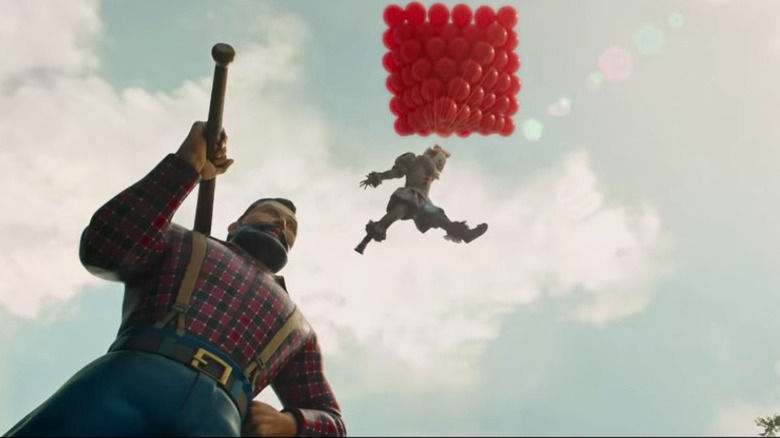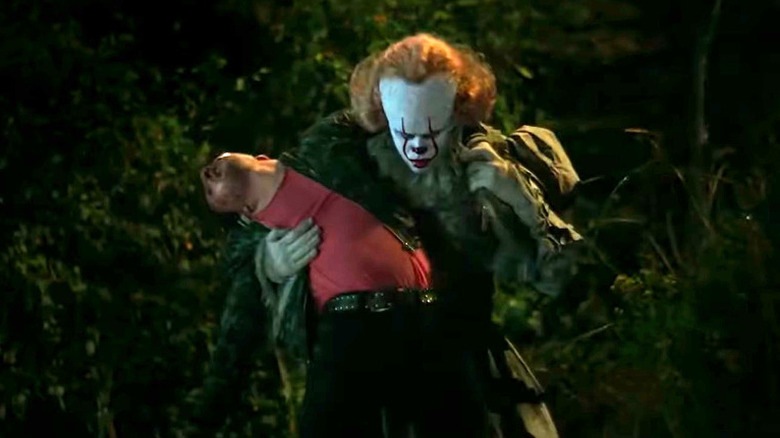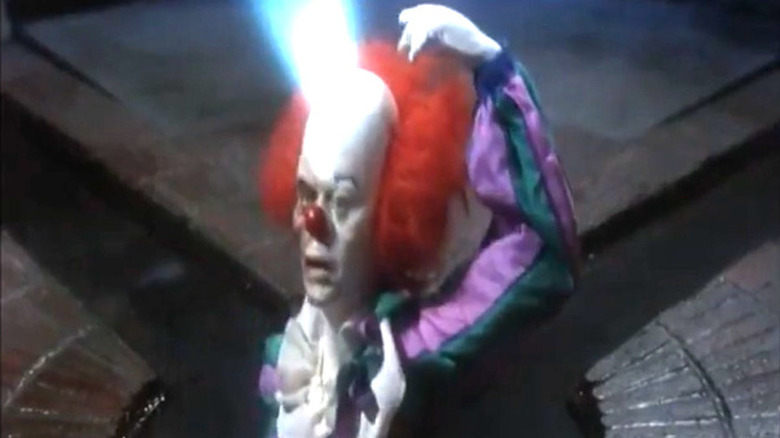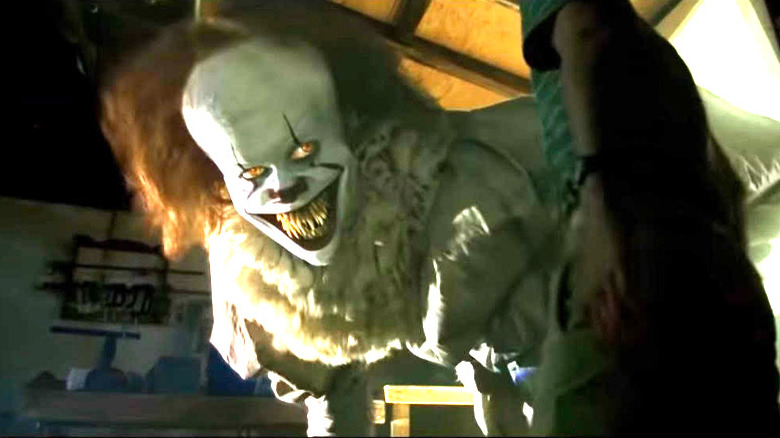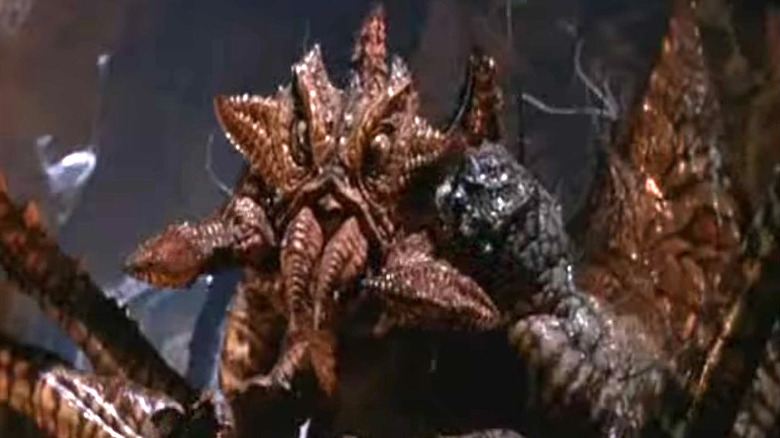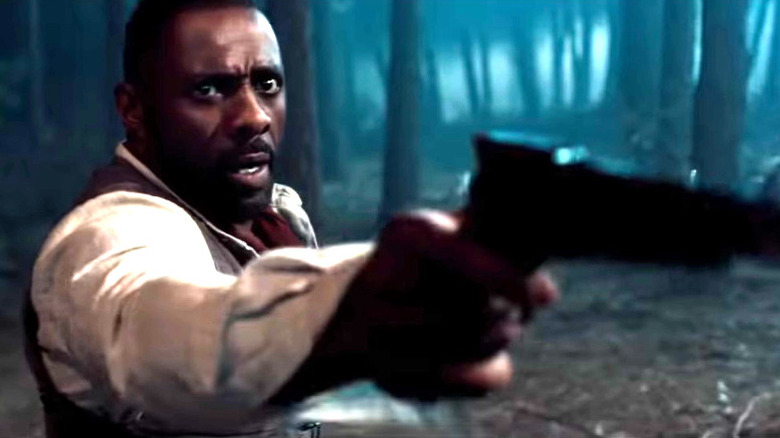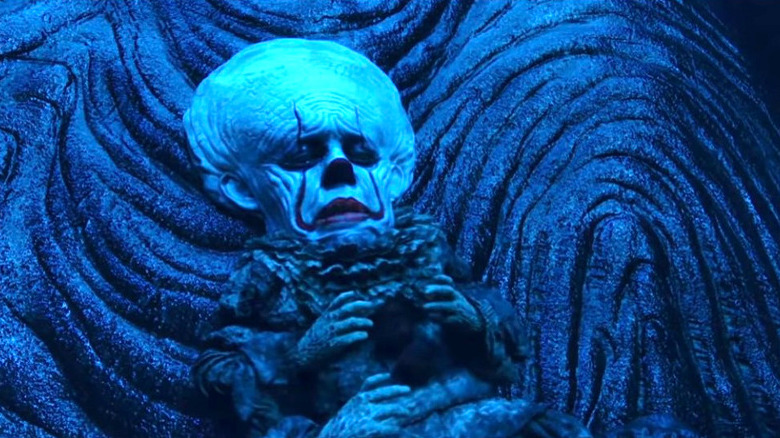The Dark History Of Pennywise
Pennywise is one of the most recognizable figures in the horror genre, right up there with Dracula and Frankenstein, or even a more recent frightful icon like Freddy Krueger. Originating in the pages of Stephen King's massive 1986 novel "It," this evil entity which likes to disguise itself as a sinister dancing clown has been terrifying audiences for decades. In 1990, a television miniseries starring the legendary Tim Curry as Pennywise was broadcast, causing an entire generation to develop coulrophobia.
Interestingly enough (given Pennywise's slumber cycle), 27 years later, a massive big-screen adaptation of the first half of King's book (that's how hefty the thing is) was released in theaters and became a blockbuster. With the success of part one, a sequel was released, called "It: Chapter Two." While not as strong as its predecessor, the second half of the clown's saga was enough of a success to prove that audiences just couldn't get enough of this interdimensional beast.
Further proof of this is the announcement of a prequel series entering development for HBO Max. While the big and small screen has been very kind to Pennywise, his full story cannot be contained in a purely visual medium. There is deep and strange lore surrounding the character that can only be fully explored in books. We're going to do our best to dive into that mythology (including a few real-life details) to get to the bottom of the dark history of Pennywise.
The troll under the bridge
The inspiration for Pennywise came to Stephen King while crossing a covered bridge, according to Bev Vincent in the book "The Stephen King Illustrated Companion." King is quoted as saying, "I was wearing cowboy boots with rundown heels, and I was very aware of the sound they made on the boards; they sounded like a hollow clock." His mind went to the story of the "Three Billy-Goats Gruff" and the troll dwelling below a bridge threatening to gobble up three goat brothers.
He imagined an evil force that could shapeshift into anything its prey feared. This gave King the freedom to write about all the classic monsters he could think of. Vincent quotes him as saying, "This book is the summation of everything I have done and learned in my whole life to this point ... Every monster that ever lived is in this book. This is it, this is the final exam."
We primarily identify Pennywise as a clown, though. Clowns have been known to frighten children, and since King was writing about childhood fears, it made sense to include the circus performer. The idea struck him while walking the streets of Bangor, Maine after a rainstorm, as his mind again went to the troll under the bridge while passing a sewer. "As I looked at this one sewer as I was going by, the voice inside speaks up again and says, 'The troll lives there too, only when he's in the sewers he has a clown suit."'
Out of the Macroverse
By now it's fairly common knowledge that many (if not all) of Stephen King's books and short stories are connected in some way. Whether it's characters crossing over, small references to places and things, or even the settings themselves, King has been creating a shared universe for so long that a television series set in his fictional town of Castle Rock was able to bring his various characters and stories together to tell brand new tales not based on specific source material.
What you may not understand, if you haven't read his books, is that his stories actually take place in a multiverse. Exploring how that works is fascinating, but would take an entire article of its own to do it justice. The important thing is that there is another space outside of that multiverse called the Macroverse. In his "The Dark Tower" cycle of books, this is referred to as the Todash Darkness and some pretty freaky things beyond our comprehension live out there.
One of its inhabitants is a gargantuan cosmic turtle called Maturin who vomited up our universe like some action out of an ancient creation myth. Maturin isn't all that interested in what happens to us, which is why another entity from the Macroverse was able to enter our space, crash into an area that would become Derry, Maine, and feed on humanity for centuries. That second being is what readers of "It" know as Pennywise, the Eater of Worlds.
Salting the meat
Fiction contains a lot of monsters driven by hunger. Zombies often shamble through post-apocalyptic worlds looking for living flesh to consume while vampires stalk the night thirsting for blood. While all these monsters have their own creative strengths and weaknesses, Pennywise (or It) stands apart because of the sheer joy it derives from hunting its prey.
The entity we refer to as Pennywise doesn't just kill and eat its food. It toys with it first. For It, eating isn't enough. The point is to savor the meal. Like a chef perfectly preparing a steak by tenderizing it and salting it just enough, Pennywise preps its food by scaring it. All the scenes where Pennywise takes the form of a werewolf, the Creature from the Black Lagoon, or a sick and rotting old man, are It's version of "salting the meat."
The flesh of a scared person tastes better than that of someone who doesn't suspect they're about to be eaten. This is why It takes so many forms: to exploit a person's fear and bring out their very best flavors. Children naturally scare easier than adults because they still believe in all the impossible things that adults lose faith in. For an adult, believing in supernatural monsters is a psychological defect. For kids, belief in monsters is a means of survival. The monster under the bed can't get you if you know it's there. Unless, of course, it decides to come looking for you.
Wake, feed, repeat
After crashing into our planet from the Macroverse, It slept deep below the ground until the early part of the 16th century, when mankind started inhabiting the land above his domain. Awakened from a long, deep slumber, it was hungry and began devouring the people going about their lives in this new world born from Maturin. After about a year of doing so, It was satiated and returned to its subterranean home to sleep for another 27 years. This was the beginning of a cycle of horror that would continue for more than two centuries.
Pennywise's natural feeding routine is to wake up every 27 years and eat the residents of Derry before hibernating. During this time, the small town goes pretty much unnoticed by the rest of the world, allowing It to feed without gaining unnecessary attention. In the middle of the 16th century, It ate so many people that Derry was virtually wiped out, like the village of Roanoke in Virginia.
Inhabitants of Derry seem to forget the entity's terrible deeds shortly after they occur. This is why the Losers' Club have no idea Pennywise even exists when he starts coming after them (in the novel) in 1957. One resident remembers seeing Pennywise the night a lumberjack killed a dozen men at the dawn of the 20th century, but didn't know It's name and never told anyone else. It is this kind of traumatic amnesia that allows Pennywise to continue feeding unchecked — until some kids decide to fight back.
A real-life murder
Obviously, there is nothing realistic about Pennywise. That doesn't mean that everything about the story in which he appears is complete fiction. One of the most horrific scenes in the book and "It: Chapter Two" involves a homophobic hate crime where a gay man is beaten and thrown off a bridge. He has asthma and struggles to keep from drowning. To make things worse, the individual offering him a helping hand is Pennywise the dancing clown.
The scene was inspired by the actual 1984 murder of Charlie Howard. In "The Stephen King Illustrated Companion," Bev Vincent writes, "The victim (Howard) did not drown after being thrown off the bridge into the stream — he suffocated because of his asthma, which King likens to being frightened to death." Vincent adds that King researched the police investigation of the murder and created a fictionalized version of it for the portion of his book set in 1985.
As reported by Slate, the choice to include the scene was a controversial one. Some saw it as cheap and disrespectful while others viewed it as a metaphor for genuine hate. Director Andrés Muschietti and star Jessica Chastain felt it was important to include because Pennywise represents the darkness in humans that society prefers to ignore. The intention of the scene may be to remind the audience that people turn a blind eye to this kind of violence all the time, but how an individual viewer interprets it is up to them.
Of Glamours and beliefs
Context is everything when it comes to Stephen King's work. When reading one of his books, everything makes a kind of emotional sense that is tough to convey on screen. King lets us into the minds of his characters, provides us tidbits of backstory that provide motivation, and fleshes out the world to such a degree that the reader can almost believe they've lived there before.
So when a character in a television miniseries suddenly shouts, "This is battery acid, you slime," before spraying a clown in the face with an inhaler, it can come off kind of silly without the proper context. The reason the Losers' Club are able to defeat Pennywise with chunks of silver and the power of friendship is because of the power of their beliefs. Back when It was floating around the Macroverse in a form of energy referred to as the deadlights, there was no one (other than Maturin) to oppose it. Upon arriving here and discovering humanity, It naturally believed itself to be the most powerful being in existence.
What the clown couldn't understand is that humankind's imagination (the very thing it exploits) is its most powerful weapon. While mythology shows that Glamours (beings who live on fear, like Pennywise) have been tormenting humanity since its creation, Maturin reveals to Bill Denbrough that an individual's willpower can hurt Pennywise. Therefore, if a kid believes his inhaler contains battery acid powerful enough to kill an interdimensional entity — that means it can.
All those powers
Being that Pennywise is an ancient entity from another universe, It isn't limited to the same rules as the rest of us. It's true form is unknowable. We do know, however, that the deadlights seem to be a kind of power source driving It, and anyone who sees that power is driven insane. In the book, Bill's wife sees them and becomes catatonic until Pennywise is defeated. This energy also provides It with a vast array of abilities only glimpsed in the film and television adaptations.
Shapeshifting and mindreading are the obvious examples. We know that Pennywise can dip into your consciousness, identify what scares you most and become that thing. What is a little less well-known is It's ability to control people. Why don't Derry residents remember when Pennywise kills and eats a bunch of them? Why is it when people move away, their childhoods become something akin to barely remembered dreams?
That's Pennywise's doing. It can control you like a puppet, or simply manipulate your thoughts and perceptions. It also appears capable of manipulating what you see, and keeping the town of Derry alive and thriving despite all the murders and the fact that most small towns tend to struggle financially. Pennywise does this to keep its supply of food endless. When It is defeated, the spell begins to break and Derry follows the same fate as so many other rural American towns. In this case, though, that's a good thing.
Pennywise may be a mother
The ending of "It" is one area where a reader can find themselves lost even with a ton of context. After following the Losers' Club from childhood to adulthood and experiencing their fears and heartbreaks for hundreds of pages, everything comes down to them standing up against Pennywise's most terrifying form yet ... a giant spider? You can be forgiven for finding It's final form a bit disappointing, but that isn't the interesting part.
This isn't just any spider. No, this is a giant pregnant spider. This throws a lot of what we believe about It out the window because this means that Pennywise can procreate. Although it's assumed that the spider is Pennywise's true form (in our reality, anyway) that doesn't necessarily confirm that It is actually pregnant. This could be another tactic to frighten the Losers' Club into thinking there are more of its kind out there.
If anything, the fact that the book makes us ask these questions proves that King really tapped into something special. When the book is finished, we have no idea what was real and what wasn't. Was It female? Did any of the eggs hatch? Were those eggs even real? That doubt is the point. We're meant to interpret the nature of It in our own way because It is (metaphorically) a product of our collective fears and anxieties. How you face those fears is personal because no one can defeat what scares you but you.
There may be more Its
For any reader really interested in wandering through Stephen King's multiverse, there's no better place to do so than in "The Dark Tower" books. The series is about a gunslinger named Roland Deschain on a quest to find the Dark Tower at the center of the multiverse and climb to the top of it. While doing so, he travels between realities, encountering characters from other Stephen King books like Father Callahan from "'Salem's Lot," Patrick Danville from "Insomnia," and multiple forms of Randall Flagg from "The Stand."
Speaking of Patrick Danville, the way in which Roland comes to meet this character is tied to "It." In the final book, "The Dark Tower," Roland ventures into the land of Empathica, where he is taken in by someone calling themselves Joe Collins. This person gets assistance from an android called Stuttering Bill and seems like a nice, funny guy until the truth sets in. This isn't Joe Collins, former standup comedian: it's Dandelo, a being that feeds on human emotions.
Dandelo keeps Danville in the basement where he eats the young man's emotions. He gets close to killing Roland, but the gunslinger and his companion Susannah defeat the creature. They rescue Danville (who can change reality through his art) and continue their quest. The fact that Dandelo feeds on emotion immediately makes the reader think of Pennywise. According to Bev Vincent, "King has stated that Dandelo is not Pennywise, but they may be from the same species."
Pennywise Lives
It would seem that having its heart crushed by Bill Denbrough would be enough to kill Pennywise for good. After all, once It is murdered, the spell over Derry dissolves, and memories of It's evil begin to fade. However, there are hints in later King books that although Pennywise is down, it may not be out.
In the novel "The Tommyknockers," a character travels to Derry and has a vision of a familiar-sounding clown in a sewer. Unfortunately, the character isn't exactly doing very well mentally, so this really could be a hallucination that just so happens to connect to a different book. A more substantial hint, though, comes from another King book about adults dealing with past traumas: "Dreamcatcher."
The alien in that book is referred to as Mr. Gray. This is similar to one of Pennywise's aliases, Robert (or Bob) Gray. The alien visits Derry in order to poison the water supply but learns that the Derry Standpipe was destroyed during the events of "It." On a plaque commemorating those who died in the 1985 flood, someone has spray-painted the words "Pennywise Lives." Was this the result of a lingering memory in the mind of a Derry resident, or a warning that Pennywise isn't done with the people of Maine? For now, that's another question only the reader can answer for themselves.
